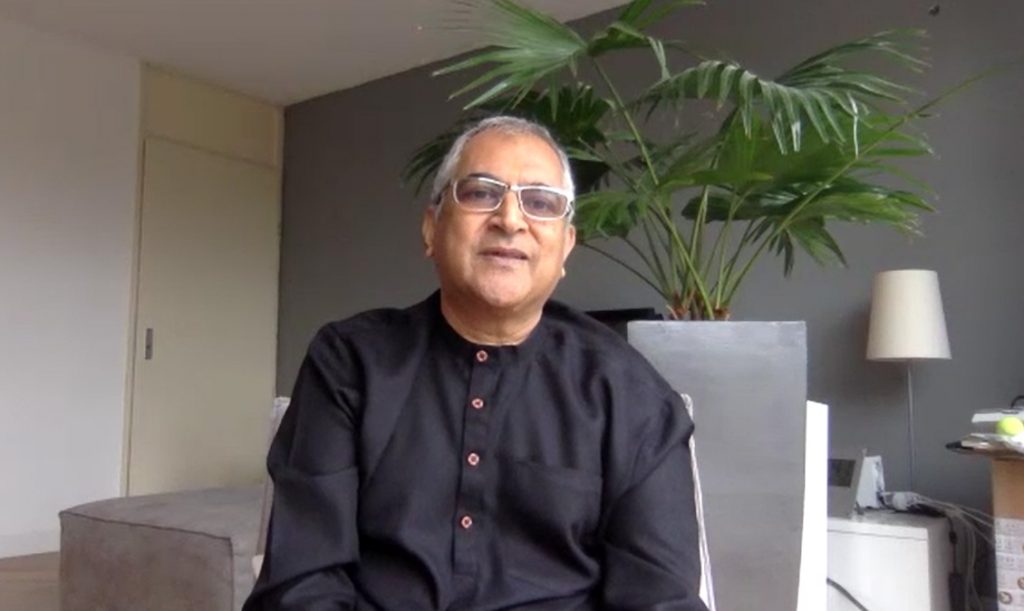Webisode-24
‘Yoga is not a Work-Out, It is a Work-In’
Shri Sudhir Tiwari, Yoga Guru,

Kaivalyadhama learned yoga under the guidance of Swami Digambar, a disciple of Swami Kuvalayananda and his father Shri Om Prakash Tiwari. His goal is to present yoga not just as asanas but as an experiential practice. As part of Webisode 24 of Online Gurukulam- Learn with Masters, we did the first one-to-one interaction with him on September 4, 2022 on our social media platforms. Here are the excerpts.
Yoga is the integration of one’s personality. Does this mean integration of mind, body and soul?
This might look like a simple question but it isn’t an innocent one. Swami Kuvalyananda ji categorised a yoga practitioner as a physical culturist whose main objective is to do yoga for psycho-physiological health reasons. But the primary purpose or goal of yoga is more than that. It is spiritual in nature. One of the definitions of yoga is Yoga Samadhau which means Yoga is Samadhi.
One of the many meanings of Samadhi is an equilibrium and harmony between our instruments of perception. These instruments of perception make a human personality. Instruments of personality become the instruments of perception. The problem arises when these perceptions transform into misperceptions. When I don’t perceive things the way they are, it creates a chain reaction which ends up in suffering and ill health. Yoga is integration of personality— an equilibrium between the instruments of perception. When there is an equilibrium in your instruments of perception, they become clear and purified. You see things the way they are and you resolve issues appropriately.
Integration of personality achieves that state when your mind, body and intellect is calm, clear and unobscured. This is what yoga achieves— asanas for the body, pranayama for the mind and dharna, dhyana, samadhi for the intellect.
What is the importance of Guru-Shishya Parampara in Yoga?
Guru-shishya parampara is rooted in our Vedas and Upanishads. Even the shanti path- peace chantings with which our ancient texts start is a dialogue between a student and teacher. The person who wants to learn shastra is a student and the link between the shastra and the shishya is the shashtri- the Guru. The focus is on the shastra. In Yoga, Guru is extremely important. The Guru decodes the ancient texts in an objective and a methodical way, and presents them to students because the verses are coded, whether it is Yoga Sutra, Hatha Pradipika, Gheranda Samhita and others.
We have seen a stage when Yoga got diluted, but times have changed. Where are we now? Is the future of Yoga in 21st century bright?
The future of Yoga is always bright. The very fact that yoga has survived the onslaught of history especially in India. The strength of our system is that it still exists today. Indian systems of thought and practices have still survived because their effects at psychological level, physiological level and spiritual level have been validated and re-validated time and time again.
Yes, we are approaching a time which is challenging in nature because certain non-yogic practices have entered the realm. In our ancient texts, Hatha Yoga and Hatha Karma are defined clearly as two different concepts. Today, a lot of Hatha Karma is qualified as Hatha Yoga. Fortunately, In India more than 98% institutes are teaching Yoga the way it should be. Some sections have started to perceive Yoga as a set of physical exercises. Yoga is not a workout, it is a work in and that distinction has to be clarified.
Can yoga help us win over our mind and reduce pain, suffering, anxiety, stress and depression?
Yes, yoga can tame the mind and all our ancient texts point towards it, even Gita. But yoga will not reduce your stress, anxiety, or pain. Rather it will empower you to deal with stressful situations that lead to agitation, anxiety and disharmony. It empowers you to handle such situations and it prepares you for life.
Pranayama is much more than breathing exercise? What is Pranayama?
Pranayama is a very important practice in Yoga. Maharishi Raman translated 30 verses of Markanday Puran which is now known as Updesh Sar or Updesh Saram. In those 30 verses, he has spoken about Karma Yoga, Bhakti Yoga, Gyan Yoga, Ashtanga Yoga. When he talks about Yoga, he only talks about Pranayama and nothing else. The question is why? Pranayama is a distinct yogic practice. In simple words, pranayama is nothing but training of our breath following a yogic protocol.
How important is it to learn Yoga and Pranayama from a qualified teacher?
It is extremely important to learn Yoga and Pranayama from a qualified teacher. All our ancient texts validate the fact. A teacher who is completely versed with a sense of Yoga, protocol of Yoga and a teacher who himself/herself practices Yoga because when you are dealing with breath you are dealing with life and you can’t be casual about it.